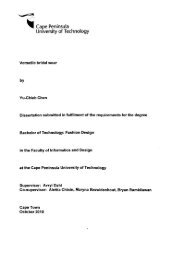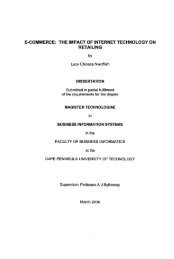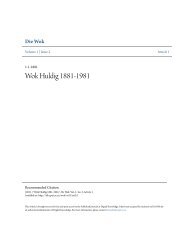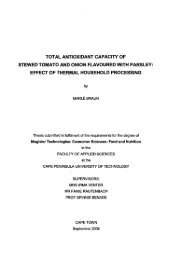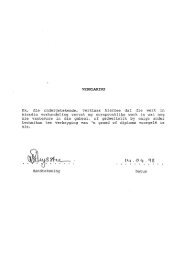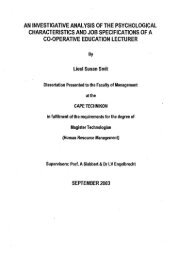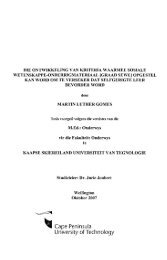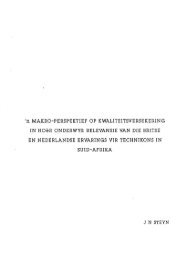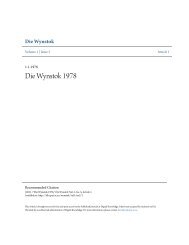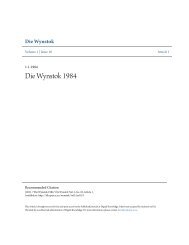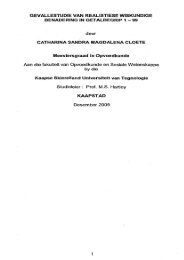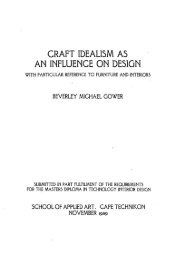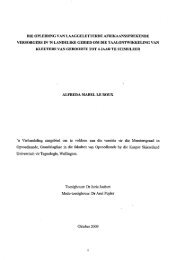the effect of the particle size distribution on non-newtonian turbulent ...
the effect of the particle size distribution on non-newtonian turbulent ...
the effect of the particle size distribution on non-newtonian turbulent ...
Create successful ePaper yourself
Turn your PDF publications into a flip-book with our unique Google optimized e-Paper software.
Chapter 2 Literature Review Page 2.41<br />
Although this correlati<strong>on</strong> does not provide an explanati<strong>on</strong> <str<strong>on</strong>g>of</str<strong>on</strong>g> <str<strong>on</strong>g>the</str<strong>on</strong>g> behaviour <str<strong>on</strong>g>of</str<strong>on</strong>g> <str<strong>on</strong>g>the</str<strong>on</strong>g> slurry in<br />
terms <str<strong>on</strong>g>of</str<strong>on</strong>g> <str<strong>on</strong>g>the</str<strong>on</strong>g> physical properties <str<strong>on</strong>g>of</str<strong>on</strong>g> <str<strong>on</strong>g>the</str<strong>on</strong>g> slurry, it does produce a good correlati<strong>on</strong> <str<strong>on</strong>g>of</str<strong>on</strong>g> n<strong>on</strong><br />
Newt<strong>on</strong>ian <strong>turbulent</strong> flow pipe data (Harris & Quader, 1971 and Quader & Wilkins<strong>on</strong>, 1980).<br />
2.12 EVIDENCE OF PARTICLE ROUGHNESS<br />
Many researchers report similarity between <str<strong>on</strong>g>the</str<strong>on</strong>g> <strong>turbulent</strong> behaviour <str<strong>on</strong>g>of</str<strong>on</strong>g> Newt<strong>on</strong>ian fluids and<br />
n<strong>on</strong>-Newt<strong>on</strong>ian slurries (Caldwell & Babbitt 1941, Hedstrom 1952, Metzner & Reed 1955,<br />
Dodge & Metzner 1959, Tomita 1959, Michiyoshi et al 1966, Edwards & Smith 1980,<br />
Thomas & Wils<strong>on</strong> 1987 and Sive 1988). One <str<strong>on</strong>g>of</str<strong>on</strong>g> <str<strong>on</strong>g>the</str<strong>on</strong>g> more interesting pieces <str<strong>on</strong>g>of</str<strong>on</strong>g> evidence to<br />
date <strong>on</strong> <str<strong>on</strong>g>the</str<strong>on</strong>g> similarity between Newt<strong>on</strong>ian and n<strong>on</strong>-Newt<strong>on</strong>ian slurry <strong>turbulent</strong> flow is<br />
presented by Park et al (1989).<br />
Park et al (1989) investigated <str<strong>on</strong>g>the</str<strong>on</strong>g> <strong>turbulent</strong> structure <str<strong>on</strong>g>of</str<strong>on</strong>g> a n<strong>on</strong>-Newt<strong>on</strong>ian slurry using laser<br />
doppler anemometry and c<strong>on</strong>cluded that <str<strong>on</strong>g>the</str<strong>on</strong>g> transiti<strong>on</strong> regi<strong>on</strong> is much narrower than for<br />
Newt<strong>on</strong>ian fluids. Their n<strong>on</strong>-Newt<strong>on</strong>ian slurry <strong>turbulent</strong> flow velocity pr<str<strong>on</strong>g>of</str<strong>on</strong>g>ile (Figure 2.16)<br />
agrees well with measurements with air (Newt<strong>on</strong>ian fluid). However, <str<strong>on</strong>g>the</str<strong>on</strong>g>y reported higher<br />
relative turbulence intensities in <str<strong>on</strong>g>the</str<strong>on</strong>g> wall regi<strong>on</strong> for <str<strong>on</strong>g>the</str<strong>on</strong>g> slurry, when compared with air<br />
(Figure 2.17). This would support <str<strong>on</strong>g>the</str<strong>on</strong>g> c<strong>on</strong>cept <str<strong>on</strong>g>of</str<strong>on</strong>g> <str<strong>on</strong>g>particle</str<strong>on</strong>g> roughness. Pokryvalio &<br />
Grozberg (1995) c<strong>on</strong>fmned <str<strong>on</strong>g>the</str<strong>on</strong>g> findings <str<strong>on</strong>g>of</str<strong>on</strong>g> Park et al (1989) using electro-diffusi<strong>on</strong><br />
techniques for measuring velocity pr<str<strong>on</strong>g>of</str<strong>on</strong>g>iles <str<strong>on</strong>g>of</str<strong>on</strong>g>Bent<strong>on</strong>ite clay suspensi<strong>on</strong>s at c<strong>on</strong>centrati<strong>on</strong>s <str<strong>on</strong>g>of</str<strong>on</strong>g><br />
4% and 6% and comparing it with air. They reported a significant increase in turbulence<br />
intensities in <str<strong>on</strong>g>the</str<strong>on</strong>g> wall regi<strong>on</strong> for <str<strong>on</strong>g>the</str<strong>on</strong>g> Bent<strong>on</strong>ite clay suspensi<strong>on</strong> (Figure 2.18), providing<br />
fur<str<strong>on</strong>g>the</str<strong>on</strong>g>r support <str<strong>on</strong>g>of</str<strong>on</strong>g> <str<strong>on</strong>g>the</str<strong>on</strong>g> c<strong>on</strong>cept <str<strong>on</strong>g>of</str<strong>on</strong>g> <str<strong>on</strong>g>particle</str<strong>on</strong>g> roughness.<br />
2.13 DATA FROM THE LITERATURE<br />
Experimental data obtained by Sive (1988) was used in <str<strong>on</strong>g>the</str<strong>on</strong>g> analysis <str<strong>on</strong>g>of</str<strong>on</strong>g> <str<strong>on</strong>g>the</str<strong>on</strong>g> various models<br />
under c<strong>on</strong>siderati<strong>on</strong>. The tests c<strong>on</strong>ducted by Sive (1988) were d<strong>on</strong>e using a mixture <str<strong>on</strong>g>of</str<strong>on</strong>g>kaolin<br />
clay and a relatively coarse quartz sand, which resulted in a heterogeneous, settling slurry.<br />
The purpose <str<strong>on</strong>g>of</str<strong>on</strong>g> using this data was to see if <str<strong>on</strong>g>the</str<strong>on</strong>g> coarse, settling <str<strong>on</strong>g>particle</str<strong>on</strong>g>s c<strong>on</strong>tributed to <str<strong>on</strong>g>the</str<strong>on</strong>g><br />
<strong>turbulent</strong> flow headloss, as proposed by <str<strong>on</strong>g>the</str<strong>on</strong>g> Slatter model.



